Prediction: this will be one of the least read articles on this site, if not THE least. Because who cares about the 200 Series of guitars and basses? Not the market when they launched back in 1984, very few folks during the line’s roughly ten year run, and pretty much nobody today. But if you’re still here…I figure if we’re gonna cover everything Rickenbacker we have to cover EVERYTHING Rickenbacker so let’s just go ahead and get through it together. Plus which, all of this has never really been documented in one place before, so I’m gonna call it a public service!
There are two things to understand up front. First, Rickenbacker REALLY liked the bolt-on Telecaster-ish design Forrest White came up with during his first stint at Rickenbacker in the early 1970s. I mean, REALLY—let me show you what I mean!
It started in 1971 when we saw four prototype models based on the design: two guitars (a standard 430 and a deluxe 470), and two basses (the standard 3000 and deluxe 3001—and no, not THOSE 3000 and 3001s):
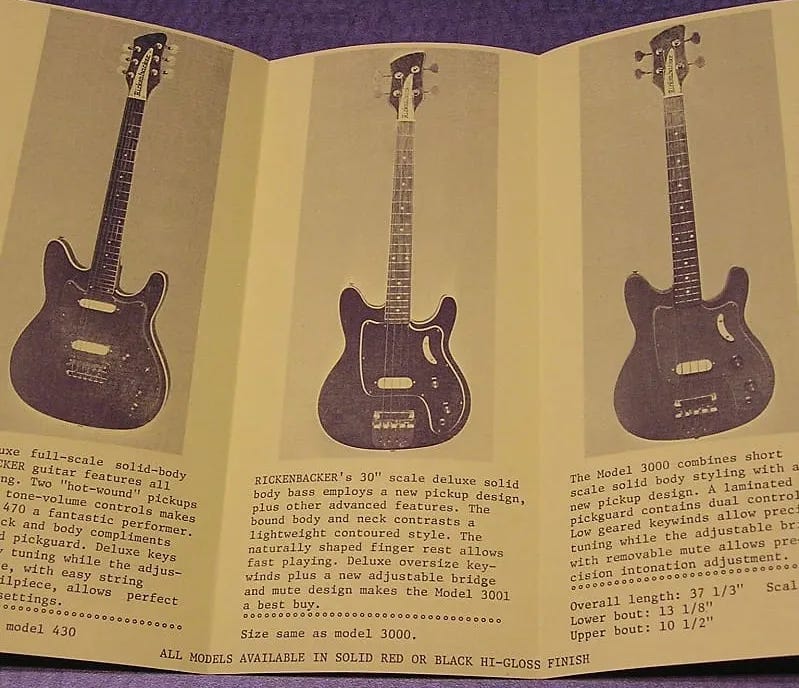
They got shown at the 1971 NAMM show…and did not make it into production. But the shape came back for another prototype—the 490 this time—in 1973:
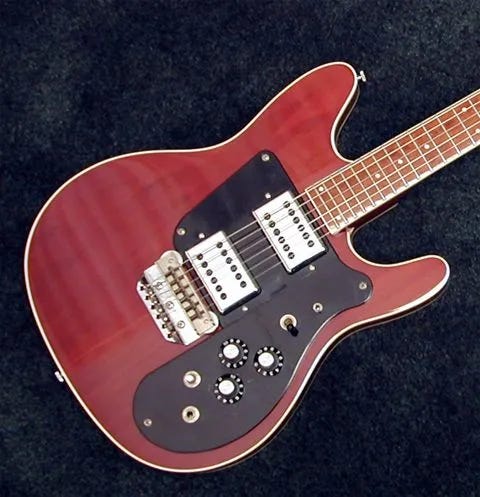
This one had a cool party trick: changeable loaded pickguards—you see a double humbucker setup here, but there was also (at least) a Telecaster-ish setup as well as a “standard” Higain configuration. It got shown at the 1973 NAMM show and…didn’t make it into production. But don’t fret—the design came back in 1975 with the 430 (no, not the one we just talked about):
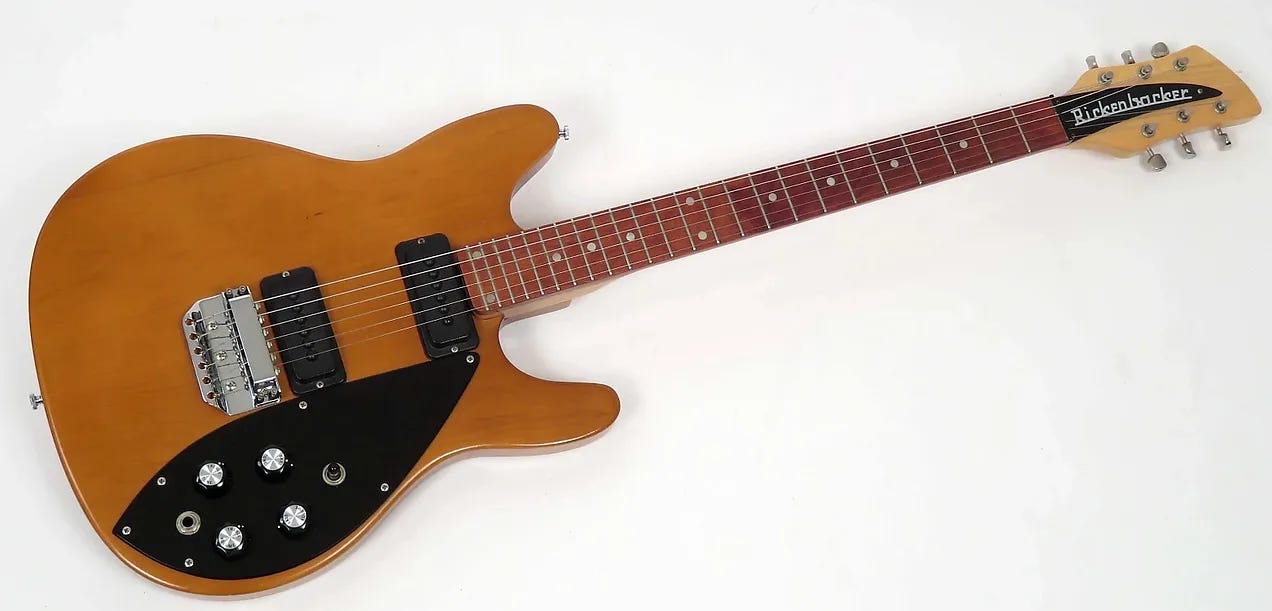
Now THIS one actually went into production! But for only a little over a year—the market took a look and said “uh, no thanks”. So Rickenbacker’s inherent belief in the market potential of that body shape—despite all data to the contrary—is the first thing to understand.
The second thing to understand is that upon taking the reins in 1984, John Hall REALLY wanted a modern guitar line to appeal to the modern guitarist—and at an value price point. It’s not that he was disdainful of the legacy models—not at all!—he just wanted to expand the brand’s reach. Probably the same thing any of us would do upon taking over a stagnant brand that was still a year or two away from an unexpected (but very welcome!) surge in demand.
So what would this whole new product line be based upon? I bet you can make a pretty good guess…
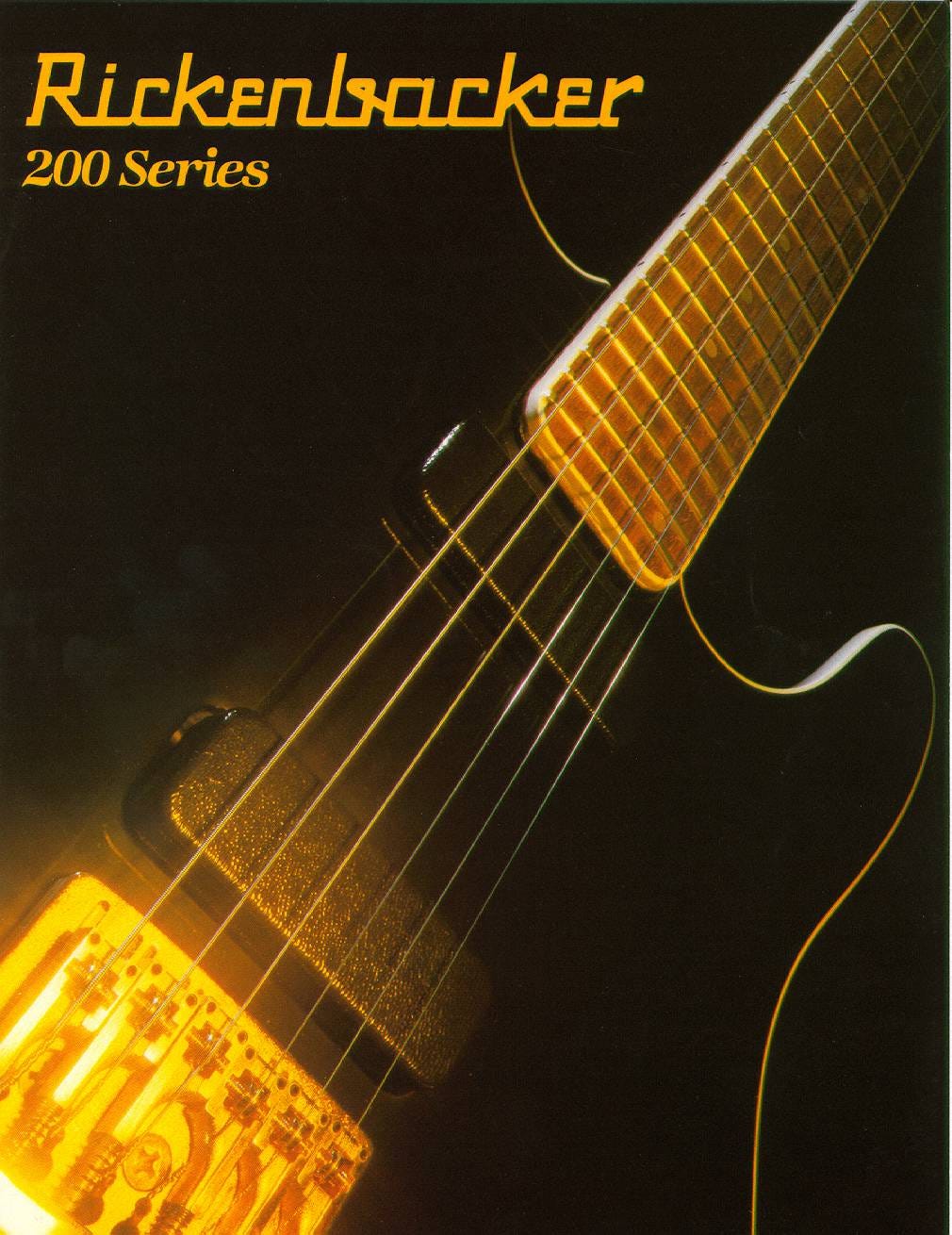
Look familiar? Yeah it does! But there’s a lot of different, unique, and dare I say kinda innovative elements to these guitars. There was also more than a little puffery involved, but that’s to be expected. Let’s break it down some.
The line launched in 1984 with two guitars and two basses. First up was the standard 230 Hamburg guitar.

The 230 featured a contoured 2-piece maple body, a 24-fret bound (white, or black for BH/BT guitars) bolt-on one piece maple neck with dot markers, and a black truss rod cover with silver lettering. Tuners were chrome or black Schaller M6 minis—the first Rickenbackers thus equipped—and the bridge was a chrome or black top-loading Schaller 3D6. The guitar had no pickguard, and featured top-mounted controls with two volume and two tone knobs and a three-way mini toggle pickup selecter. As to the electronics…we’ll get to those in a minute cause there’s quite a bit going on with them!
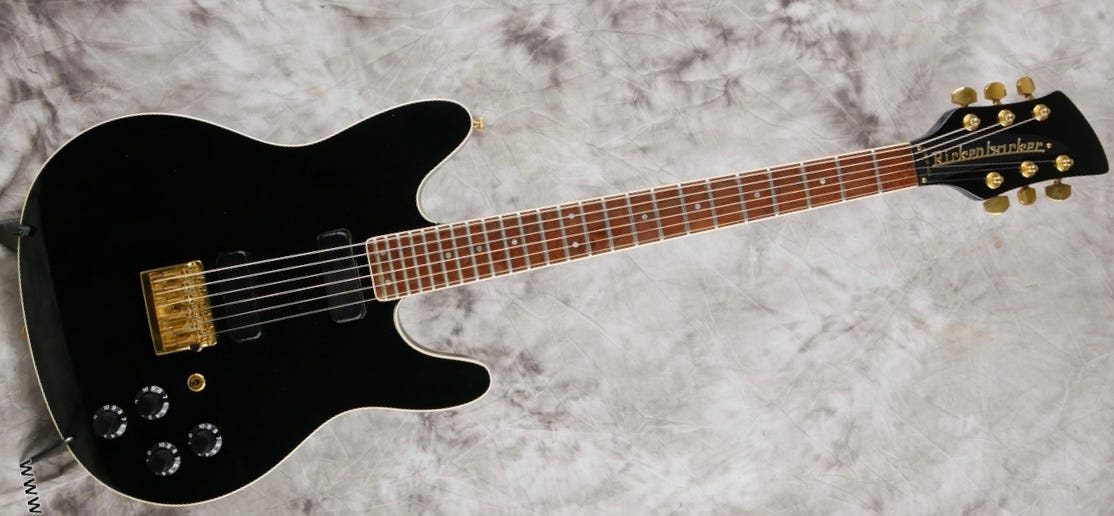
The deluxe 250 El Dorado was identical apart from a double-bound flat-top body (white, or black for BT), gold lettering on the truss rod cover, and gold Schaller hardware—thus the “El Dorado”. While BT guitars were produced, BH/BTs were not—all El Dorados had gold hardware.
“El Dorado” makes sense for the deluxe guitars. But why “Hamburg” for the standards? Occam’s Razor would suggest an attempt at a Beatles-esque aura, and I suppose that’s as good an answer as any!
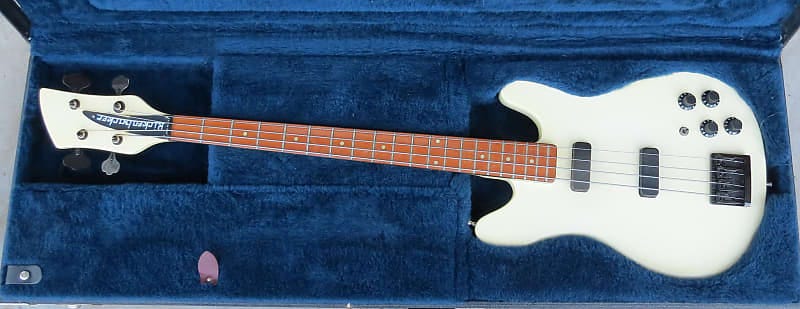
The 2030 Hamburg was the standard bass. It featured a contoured 2-piece maple body, a 20 fret bound (white, or black for BH/BT guitars) bolt-on one piece maple neck with dot markers and a black truss rod cover with silver lettering. Tuners were chrome or black Rickenbacker-branded Kluson-style tuners made by Schaller—again the first Rickenbackers thus equipped—and the bridge was a chrome or black top-loading Schaller 3D4. The guitar had no pickguard, and featured top-mounted controls with two volume and two tone knobs and a three-way mini toggle pickup selecter. It featured the same electronics as the guitars which, again, we’ll talk about in a minute.
Now you may have noticed that the bass DOESN’T have “the body”. But neither is it new. Tell me if this doesn’t look a little familiar:

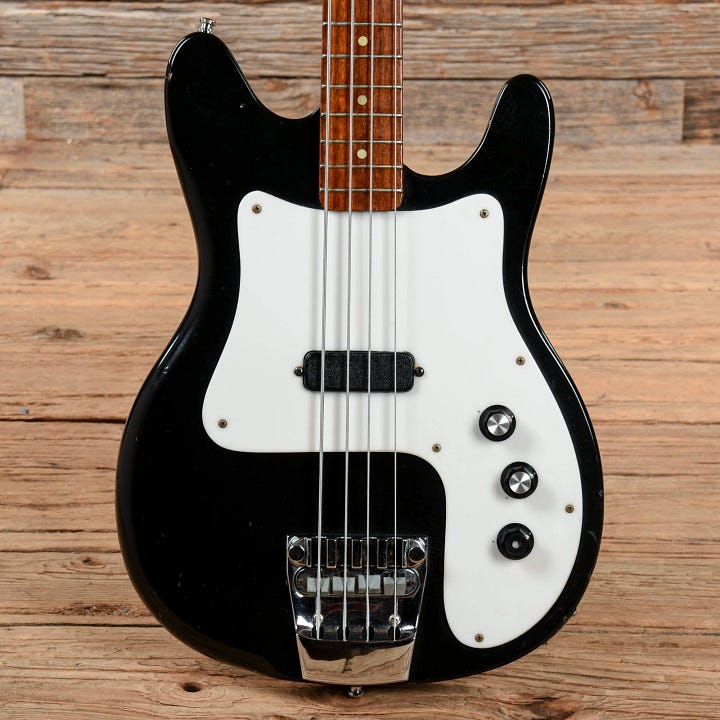
Yup. Same as the 3001. Which is, of course, another Forrest White design from the early 1970s. So maybe not “the body”…but certainly “the body’s” cousin!

And finally we have the deluxe 2050 El Dorado—identical to the 2030 apart from a double-bound flat-top body (white, or black for BT), gold lettering on the truss rod cover, and gold Schaller hardware.
Ok, so far we have decidedly non Rickernbacker-ish, fairly generic Telecaster-esque and Jazz Bass-ish guitars. I think the “El Dorado” versions are actually good looking enough, but still nothing that really makes them stand out. What’s the selling point? Let’s hear what Marketing (by which I mean John Hall!) had to say at launch:
The Most Important Link
A guitar is most certainly the complete sum of its individual parts. But the pickup is the true link between string motion and your amplifier. And the 200 Series are about to write a new chapter in pickup history…a disarmingly simple single coil design, magnetically intertwined to produce humbucker-like action. And power…lots of power. It’s packed in a revolutionary shell which further isolates the coil from annoying hum.
The Second Important Link
Active control circuitry abounds today and the 200 Series is no exception…with one tremendous difference. There is no battery. No transistors. And no integrated circuits. There is nothing to pollute the previously obtained audio signal and nothing to fail during performance. A hybrid combination of traditional subtractive elements, along with a revolutionary additive design uses the excess power generated by the pickup to create something like magic…one guitar for all purposes.
How Clever Can You Get?
All control circuits are secured on a circuit board module, ingeniously loaded from the rear of the guitar…fully shielded from electronic noise or interference…Pickups simply plug directly onto the module. We thoughtfully even provided a recess to hide unsightly cord ends of virtually any type.
—1984 200 Series Marketing Material
Wow, that sounds great! Now let’s pare back the marketing b.s. and see what’s really going on. And we’ll start with the pickup—and it is the same pickup for both the guitars and basses. And if you thought, based on the pictures above, that it’s the same pickup as was in the 3000 and 3001…it is. The case is slightly modified because it’s mounted differently—which is ANOTHER thing we’ll get to in a minute—but the guts are the same.
So how did they market the pickup when it first appeared on the 3000 and 3001? Well, period literature called it a “hum-cancelling pickup of extraordinarily wide and high output”. Okay, sure. Lets look at the backside and see what we can see.
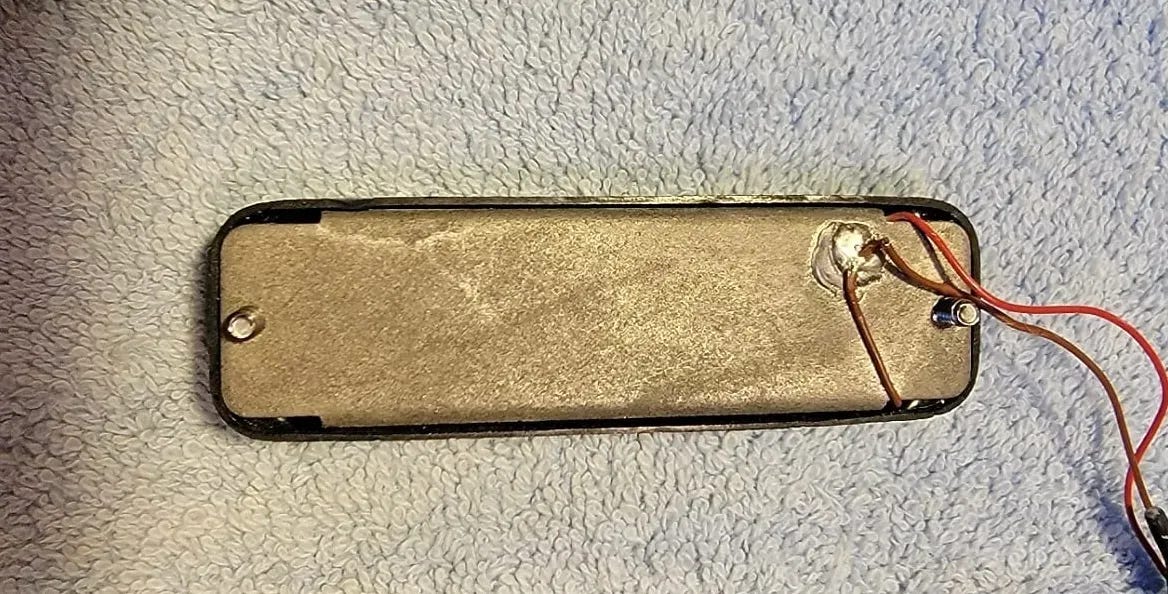
Well that’s not much. I can’t find any pictures of what’s under THAT, but here’s what we know. That gray metal you see is a u-shaped frame. Inside that is a wound steel rail with a samarium cobalt magnet at the bottom. The whole thing is then encased in epoxy which ends up more or less bonded to the plastic cover. So if anything breaks…it’s gonna stay broken.
Output is about 8.5k ohms. So not exactly “power…lots of power”. It’s actually less than period Higains AND toasters! Is it “a revolutionary shell which further isolates the coil from annoying hum”? I mean, maybe? Does that metal framework provide some shielding? Probably. Does the epoxy? It technically could—depending on the epoxy used. Let’s just say it is certainly possible.
So now we get to the “active circuitry with no battery”. I didn’t realize that was a thing! Spoiler: it’s not. By definition. Okay, so not active. The Bacon/Day book refers to it a “passive boost circuit”. Now that is a term one hears bandied about, but any type of boost requires a power source…which we don’t have here. What that term usually describes is a capacitor that rolls off the highs and lows, giving the impression of a mid boost. So what’s actually happening here?
Well, we need to take a look at “how clever can you get?” circuit board. So…let’s have a look at it.
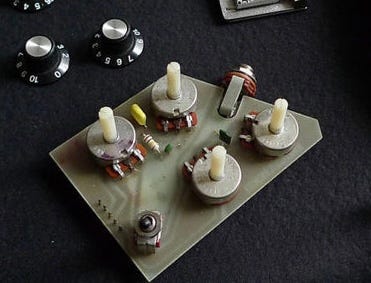

It’s a PCB control panel with quick disconnects for the pickups. Now PCB control boards had been used in guitars with active electronics like the Gibson RD Artist for some time, but that was to support complex circuits. I can’t say this was the first application of PCB wiring for a passive guitar—I’m not certain what that is—but it’s certainly an early application of the technology as a cost saver, as we see it used today. Pretty clever indeed on a “value” line!
As far as the circuit itself…I dunno. I can’t find a schematic and even if I could I’m no electrical engineer. I count four capacitors and/or resistors, which is only one more than the “standard” Rickenbacker four knob circuit. It probably is some kind of “passive boost”. Is it “a hybrid combination of traditional subtractive elements (ie high/low pass filters), along with a revolutionary additive design”? Probably not revolutionary, but different for Rickenbacker.
So removing all the marketing b.s. what we have are (probably somewhat) hum reducing (but not new) pickups, a PCB control panel, and a new (for Rickenbacker) tone circuit. See how much clearer that is?
The last interesting features we should call out are on the backs of the guitars. Let’s take a look.
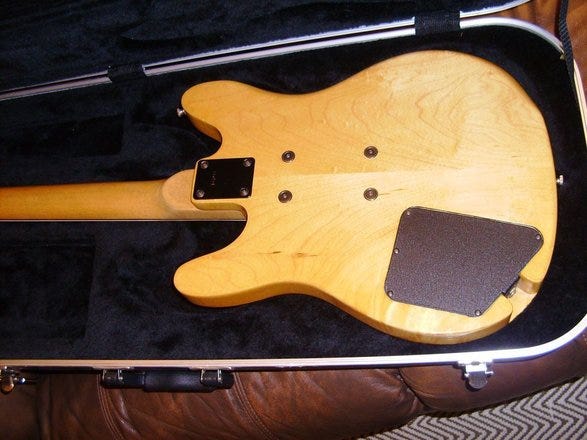
First note the large control cavity cover and how the output jack is mounted on it: a bent tab recessed into the body some. I’m not sure if that’s really useful or not, but it is kinda clever. Then there’s the neckplate for the bolt-on neck, which bears the stamped serial number.
And then there’s those four large screws. What are those? They’re how the pickups are mounted and adjusted! Here’s the back of the pickups:

Technically this is the (spoilers!) next generation 200 Series pickup, but the concept is the same—two threaded mounting “legs” are affixed to the back of the pickup which receive the mounting screws inserted through the back of the guitar. Clean and clever.
So…a modern design to appeal to modern players at an appealing price point. That was the spec. Did it deliver? Well…the price wasn’t bad for a 1980s American-made guitar! MSRP for the 230 clocked in at $459, the 250 was $599, the 2030 was $549, and the 2050 was $699. For comparison’s sake, at that point a 610 was $599, a 620 was $729, a 4003S was $819, and a 4003 was $899. For further context, the cheapest US-made Telecaster and Jazz Bass were $589 and $799 respectively. So again, not bad. But appeal? Whatever the sales expectations were—and I have no idea WHAT they were—the line did not meet them. But they didn’t give up on it. The product line lasted about ten years before they ultimately pulled the plug.
There were a few tweaks along the way—some minor, some major. The first change was a minor one. The 200 guitars were outfitted with brand new knobs—the first since the silver top knobs appeared in 1964! The unlabeled knobs were somewhat similar to the “witch hat” knobs found on Fender amps or Gibson guitars—black with numbers printed on the skirt, but with ribbed barrels that were more cylindrical than the conical witch hat knob. These came with a silver (for the 230 and 2030) or gold (for the 250 and 2050) top.
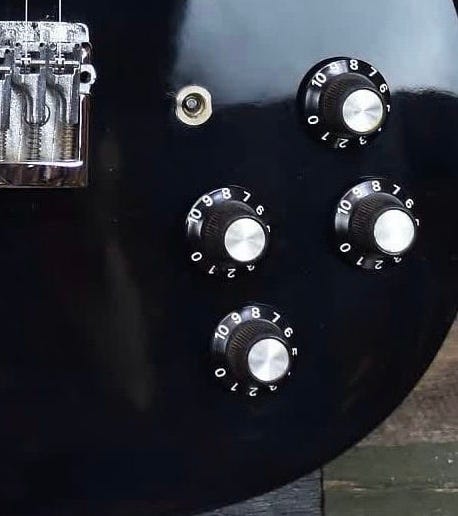
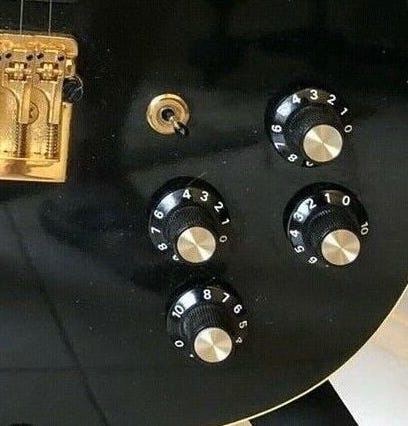
But these knobs did not last long at all. Beginning in mid 1985 both the silver and gold topped versions were replaced by a similar knob with a plain black top.
Now a major tweak—and one that really delivered on some of the original ambitions. In 1988 the pickups were replaced with the new HB2 humbuckers. “HB2?” you ask? “I know what an HB1 is, but what is an HB2?” I’m glad you asked!
The HB2 is visually identical to the old pickup but (obviously) different under the hood. Two steel rail coils sit atop a samarium cobalt magnet, with the windings attached to a small PCB board. The case is then filled with epoxy. Just like the old pickup, if it breaks…it’s broken. Now you may have noticed in the picture above that the PCB board has four leads to allow for coil splitting and the like, but that was not taken advantage of here.
So why bother adding them? Because the difference between the HB1 and the HB2 was…the case it was shoved inside. That’s it. Same pickup, different wrapper. And here’s a fun fact—the HB2 appeared on the 200 Series guitars BEFORE the HB1 first appeared on the John Kay 381JK Signature Limited Edition guitar, its first application. But the pickup was DESIGNED for the 381JK—thus all the fancy multiple leads—so that “version” of the pickup got the HB1 designation and the 200 Series version got the HB2 designation.
Now these guys are HOT—like in the 14k ohm range compared to the 7.2k-ish you get from scatterwound toasters or 12k-ish you’d get from contemporary Higains. That’s in the range of pickups like the Dimarzio Super Distortion and Gibson Dirty Fingers. If you’re gonna get one of these guitars and you want it to go easily from clean to dirty…get one with the HB2s.
But here’s the thing: you can’t tell just by looking at the guitar which pickups it has. You have to look at the back of the pickups to know for sure. Kinda. You see, from launch in 1984 to late 1991/early 1992—and remember, the pickup change happened in 1988—the pickups had textured black plastic covers like so:
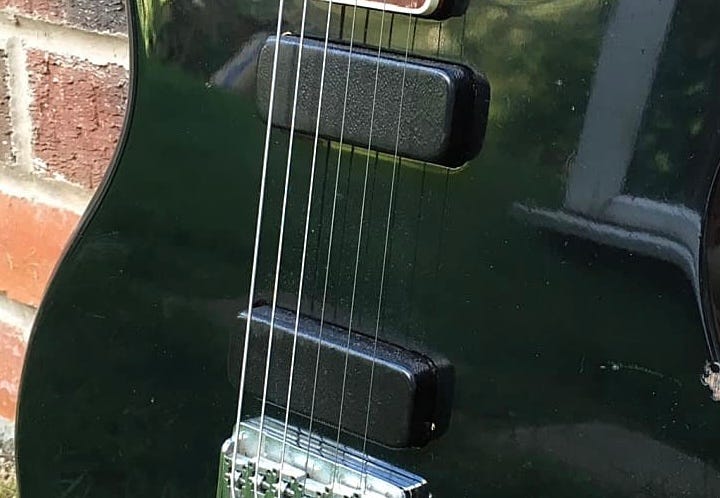
In late 1991/early 1992–and I apologize, cause this is a little hard to make out—the black plastic covers got an embossed line and “RIC” logo on the bottom:
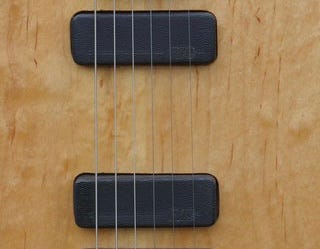
This embossed area was filled in with white paint in mid 1992:
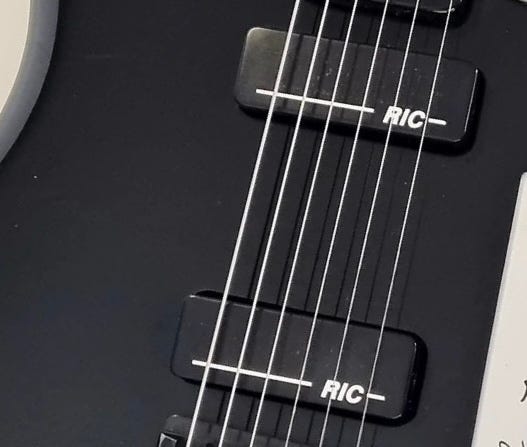
So embossed or embossed and white…HB2s. Plain black? Probably HB1s from late 1988 on, but no way to know for sure without taking them out. But you might have noticed a pickguard-ish spoiler in that last picture…
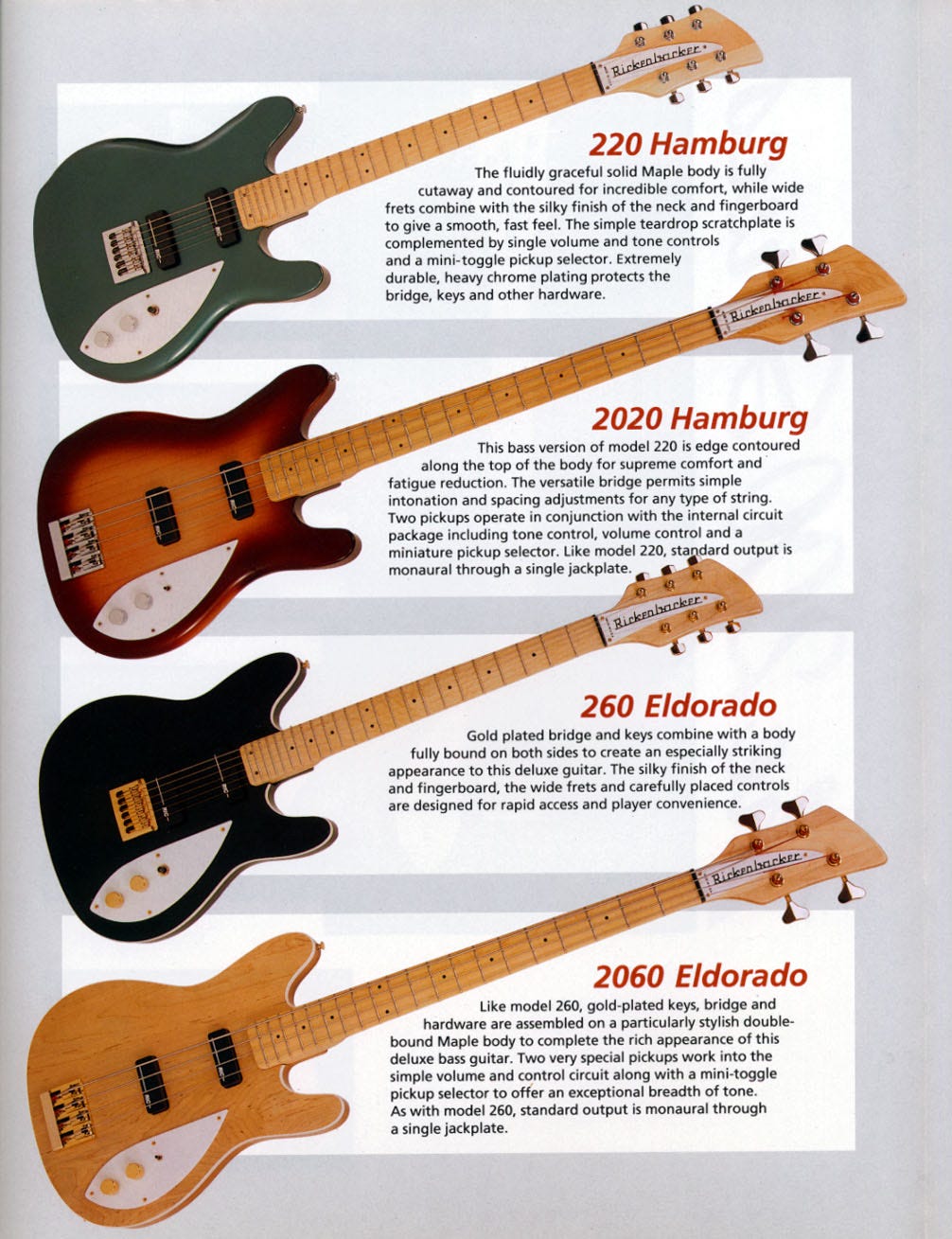
In late 1992 the line got a refresh—and brand new model numbers to reflect the changes. The former 230 Hamburg became the 220 Hamburg.
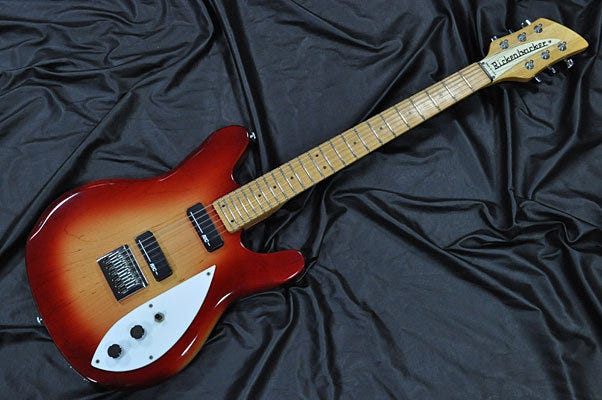
The most dramatic change was obviously the neck, with the bound and finished bubinga board being replaced with an unbound and oiled maple board. Additionally, the truss rod cover changed to white with black lettering (BH/BT models got black with white lettering), the body got a single level teardrop pickguard, controls changed to a hand-wired pickguard mounted 2 knob/1 normal sized toggle switch layout with a more traditional side output jack, and the guitar got a new bridge.
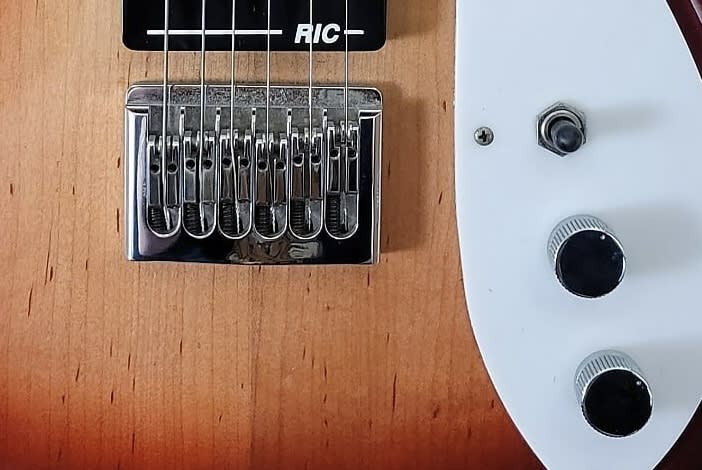
If that bridge (and those knobs!) look familiar they should: it’s the same ABM unit that appeared on the 650 guitars when they launched in 1992 (along with the 650’s ribbed chrome knobs with a dot on the top).
One last super pedantic detail: look closely at the pickup selector toggle and note the hexagonal bushing. Whether or not that indicates it’s a different toggle underneath I can’t say, but every other modern Rickenbacker has featured a round, ribbed bushing. Now you can’t unsee it!
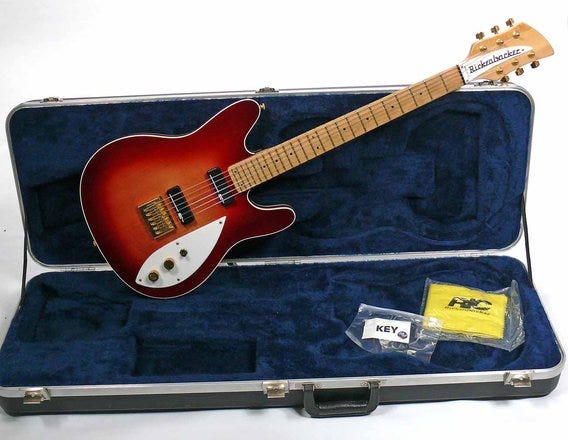
The 250 El Dorado became the 260 El Dorado. Most of the features were identical to the 220 apart from the gold hardware and the double bound body.
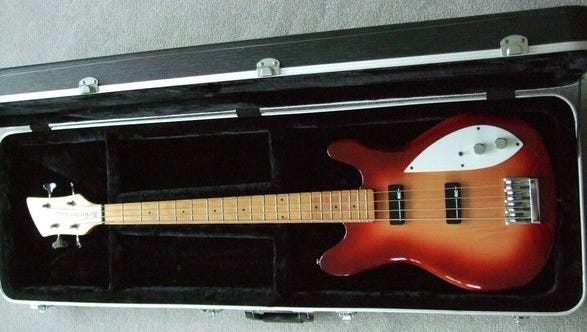
The 2020 Hamburg became the 2030 Hamburg. It saw the same changes as the 220–no neck binding, oiled maple board, white truss rod cover, added pickguard, 2 knob/1 switch wiring with side output jack. Unlike the guitars, it kept the Schaller bridge—and the mini toggle! It did, however, get new tuners—Schaller M4s.
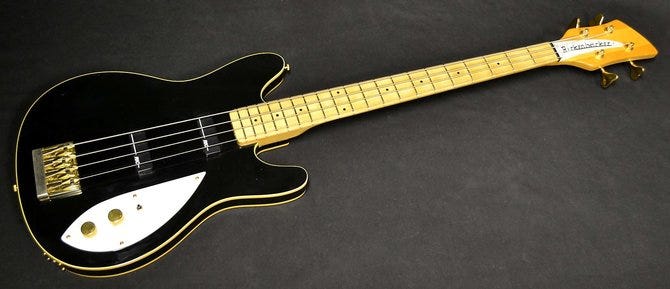
And finally, the 2050 El Dorado became the 2060 El Dorado. All features were the same as the 2020 apart from the gold hardware and double bound body. There would be no significant changes to these revised 200 Series guitars.
In 1992 the Glenn Frey 220GF and 2020GF Signature Limited Edition models were released, based (despite the model numbers) on the 230 and 2030. They proved to be about as successful as their “donor” guitars, going on to be the only Signature Limited Edition model to NOT meet their full “authorized” production number (250). You can learn more about them here.


The 200 Series would be quietly dropped from the price list in late 1995, but production had already effectively ended in early 1994 (apart from the Glenn Frey models). Despite a ten year run, the guitars never really “broke through”.
So why did they fail? A combination of factors, I suspect. The Rickenbacker brand carries an image in the market’s mind—with attendant baggage—and the 200 Series guitars simply weren’t compelling enough in terms of either looks or features to change or overcome that image in new consumers’ eyes. Maybe if they had launched with the HB2s that would have helped…but as it was they were too little too late.
And while they didn’t convince new customers that they were a “different kind of Rickenbacker”, existing customers didn’t think they were “Rickenbacker enough”. It was a difficult needle to thread…and they didn’t.
And then Rickenbacker’s fortunes really changed fairly early in the models’ run. Demand for core products organically boomed in the mid to late 1980s without the company really doing much to stimulate that boom. So the “need” for the line to succeed disappeared pretty quickly—if anything, the guitars became a distraction, and they stopped actively promoting them.
Hall would take another crack at the “modern guitar” market with the 650 models—which were more successful than the 200 Series, but still not successful enough to become part of the core line. Maybe Rickenbacker as a brand is too established in the public’s mind to change? Would you buy a Lincoln sports car—no matter how good the reviews?
Wow. That ended up a lot longer than I thought it would be. But it’s probably the deepest dive that’s ever been done on these guitars…and now I don’t have to think about the 200 Series ever again! Want to learn more about…everything else? Check out the rickenbacker101 site map and see what’s already been covered! Have a suggestion about what we should tackle next? Drop it in the comments and we’ll add it to the queue.



Interesting guitars. I've never seen one but then again, I probably wasn't looking. But I do like the 260 Eldorado and 220GF. Even those were available 30-something years ago they look like guitars being marketed today.
I liked the muteless version of the Rick bridge/tailpiece on the prototypes. But the Abm/Schaller bridges were even better.